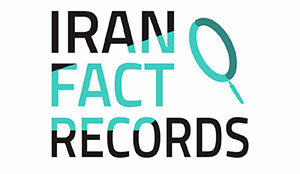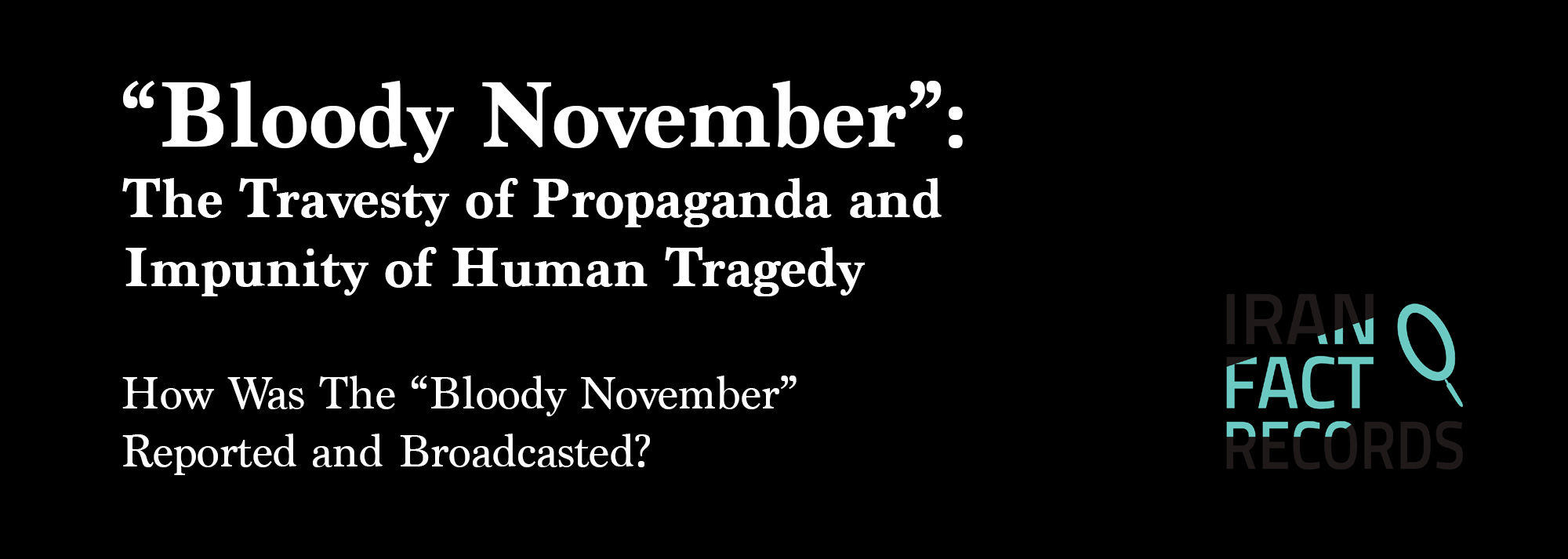Read/Download Full Report in PDF format
“Bloody November”: The Travesty of Propaganda and Impunity of Human Tragedy
How Was The “Bloody November” Reported and Broadcasted?
This report is dedicated to the brave and unsung heroes of Aban 1398 and their families. Those who gave their life and freedom for a Free Iran. We stand alongside them and the greater Movement for Truth and Justice in Iran.
“We know a massacre has taken place; the question remains however: how can we explain it”
— Arnold Hottinger, the only journalist present in the aftermath of Hama Massacre of 1982
Preface
This report scrutinizes the journalism and broadcasting of the tragic events of November 2019 (Aban 1398) that are now widely recognized as the bloodiest crackdown by the Islamic Republic since its founding in the advent of the 1979 Revolution . The scale and caliber of the atrocities have since been the subject of numerous reports by mainstream human rights organizations, major media outlets, and research think tanks, yet no state entity or authority has assumed any responsibility for the massacres. In fact, the state military-intelligence and security complex in tandem with the regime’s revolutionary judiciary have persecuted and terrorized the victims’ families into silence and have thus sought to enforce a nationwide repressive campaign to cover up the true number of the victims.
In the face of the Islamic Republic’s systemic crackdown on any effort by individuals or the media to record and document the true scope and depth of the atrocities and the number of victims, several organizations, mostly based outside Iran, continue to carry out the painstaking task of documenting this nationwide historic state violence. In November 2021 (Aban 1400), the Aban’s People Tribunal attempted to shed some light on many of the atrocities of the Bloody November in a symbolic, but judicially steadfast manner, to seek justice for the victims.
Living in the age of instant news dissemination, it is a primary concern of the present undertaking that the reporting on the origins, scale and mechanisms of the November 2019 massacres are yet to reach the scale of Bloody November’s tragic events. Proportional to their vast budgetary and specialist capacity, the many media outlets, human rights NGOs, and major think tanks have yet to produce thorough and incisive investigative reporting of the atrocities. Some entities, primarily those based in Iran, and in compliance with the mandatory security directives of the Islamic Republic, have managed to spin the peaceful popular uprising as a violent revolt by street thugs. By deploying narrow and reductionist public opinion manipulation techniques, they have sought to account for the root causes of the protests as having been fueled by “an unexpected rise in gasoline prices”, and have justified the regime’s disproportionate brutal military scale response as a self-defense in response to “widespread” and “criminal” vandalism. In so doing, they have thus eliminated the true origins of these protests in the broader context of socio-political protests in Iran during the recent years. Many have consistently labeled the November 2019 protests as apolitical, momentary, short-lived and violent and ascribed their occurrence to a consequence of international sanctions on the Islamic regime in Iran. As our investigation illustrates, this reductionist and manipulative narrative has developed into an arm of the Islamic Republic’s propaganda machine whose tongs have reached the Western European and North American media. In some cases, the regime’s propaganda has influenced some of these world-renowned media outlets’ reporting, leading them to, at worst, a cacophony of the regime’s “fuel-caused-the-riots” claims, and at best, an assortment of many equivocal paraphrasings of the true origins of the Bloody Aban riots.
The above-mentioned reports characteristically place the adversarial relations of the US and the Islamic Republic of Iran at the core of analytical explanation, and one might say as “the international backdrop” of the root causes of the Bloody November, as well as any other significant socio-economic trouble that is presently plaguing the Islamic Republic. Such an atrocious analysis functions as a propaganda arm of the Islamic Republic in a twofold sense: On the one hand, it distracts from the manner by which the Islamic Republic has evolved into a full-fledged kleptocracy, masquerading as a constitutional theocracy governed by some measure of “ostensibly” popular representation. And, on the other hand, it normalizes the tyrannical repressive measures deployed by the regime as “expected” reactions of any “average” government to “an unfortunate socio-economic downturn” that can happen “to any country,” leading to some measure of collective and humanitarian strife. All such reports rely on “expected reaction of any state” to spin the Bloody November as a tragic “footnote” to US-Islamic Republic animosity and hide the true scale of the systematic massacre. Thus, in the next segment, and before delving fully into our discussion of the (mis)representations and (mis)reportings of the Bloody November press, media, NGO, and think tanks, our report cannot but offer a concise preface to the political, social, institutional and economic catastrophes that have inflicted much suffering upon Iranians over the past four decades. The reports’ analysis hinges upon identifying the mechanisms instrumental to the repeated generation of such misinformation. We believe that a critical review of such reporting is essential to a factually informed and truth-based approach to “Exposing and Making Visible the Atrocities as Crimes against Humanity; an approach that fits the totalitarian political environment and dire Human Rights situation in Iran.
Our investigation contends that the international community is consequently still in the dark almost two years after such a wide-scale massacre, due to the systematic failure in the reporting of the Bloody November on at least three counts:
- the human rights violations committed by the state or its agents at the time, namely, the physical suppression and massacre of the victims;
- the ongoing human rights violations, namely the ones committed against the families of the slain or the detainees;
- the narrational-propagandist oppression of the Bloody November.
To accord justice to the first two, the present report contends, one must rectify and counter the Islamic regime’s propaganda and its witting and unwitting aiders and abettors. Doing so requires the provision of a factually informed account of what happened in November 2019, which may prove to be an important turning point in contemporary Iranian history. The authors’ endeavor is thus not limited to exposing the Islamic Republic’s propagandist and manipulative machinations to “deny” and distract from its principal role in the commission of crimes against humanity during November 2019. Rather, they wish more importantly to expose how the non-Iran-based media have become the witting and unwitting arms of the regime’s propaganda. In the course of achieving the latter, the report apprises the media, journalists and analysts who are covering Iran and Iranian affairs of these methods, so that they may be sensitive to the ostensibly innocent sophistry of the regime’s propaganda and many of its Western-based proxies that masquerade as pundits, professional journalists, and think-tank analysts. Reducing the complex struggle of the Iranian people against the Islamic Republic regime to –more often than not– externally induced (i.e. US sanctions and the like) socio-economic events effectively abandons the Iranian people in their fight for democracy. This is how, for example, a popular uprising –which is but one link in the long chain of Iranian society’s centennial struggle for democratic constitutionalism– is rendered an isolated incident or some urban revolt born out of a decision-making faux pas. Such reductionist takes in reports and analyses have contributed to concealing the systematic nature of continuous and exacerbating repression over the past few decades. In this report we underscore the following:
- How some reports and interpretations have managed to help the Islamic regime deny these Mass Atrocities;
- What mechanisms have been used to support this act of denial. Denial of atrocities requires certain discursive and propagandist elements that are generally used by the Islamic regime’s apologists in their quest to steer and control public opinions.

